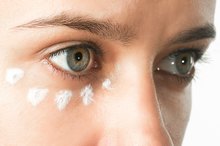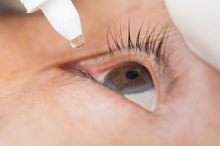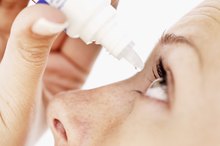How to Get Rid of Puffy Eyes From Allergies
If you have allergies, you know it is not unusual for those allergies to affect your eyes. The eyes can become red and itchy, and the skin around the eyes can become puffy. This eyelid swelling, along with other allergy symptoms, can be treated by identifying the cause of the allergic response and limiting exposure 2. Use of cold compresses, eye drops and oral medication may also be helpful.
Mechanism of Swelling
Puffiness of the eye happens when your immune system is exposed to an offending agent, or allergen. The allergen triggers release of histamine, which stimulates nerves around the eye and dilates blood vessels, causing swelling. Histamine release is typically associated with an intense itchy sensation. Treatment of eye puffiness is geared toward limiting exposure to the offending agent, blocking histamine effects or preventing histamine release 2.
- Puffiness of the eye happens when your immune system is exposed to an offending agent, or allergen.
- Treatment of eye puffiness is geared toward limiting exposure to the offending agent, blocking histamine effects or preventing histamine release 2.
Stopping Exposure
Allergy Symptoms of Mold & Mildew
Learn More
Sometimes it is difficult to identify what is causing an allergic response. Keeping a journal documenting your symptoms and what you are exposed to at the time of your symptoms can be helpful for identifying triggers. For example, you may note that your eyes become swollen and itchy when visiting a friend who owns a dog. You may note eye swelling when using a certain nail polish or perfume. Avoiding exposure to allergy triggers is the first step in preventing allergic reactions. Sometimes the cause is not obvious, especially if you suffer from allergies all year or seasonally. Allergy testing and treatment -- in addition to avoidance -- is often needed with these situations 2.
- Sometimes it is difficult to identify what is causing an allergic response.
- Keeping a journal documenting your symptoms and what you are exposed to at the time of your symptoms can be helpful for identifying triggers.
Surface Treatment
Applying a cold compress can reduce eye puffiness. Refrigerated artificial tears applied to the eyes a few times daily can also help alleviate eyelid swelling. If these self-help remedies fail, your eye-care professional can recommend other treatments. She may suggest medicated antihistamine eye drops. Steroid eye drops are also commonly used to control allergy symptoms. Most of these medications can be used as needed, meaning only when symptoms flare up.
- Applying a cold compress can reduce eye puffiness.
- Refrigerated artificial tears applied to the eyes a few times daily can also help alleviate eyelid swelling.
Systemic Treatment
How to Stop Constant Coughing From Allergies
Learn More
If allergic symptoms persist, your eye doctor may recommend you also see an allergist, who will run tests to identify all the agents that trigger an allergic response. He will work in conjunction with your eye doctor to reduce or eliminate your allergy symptoms, including those involving your eyes. This may include starting a systemic medication, whether oral or via injections, that blocks histamine release and prevents swelling and itching from starting.
- If allergic symptoms persist, your eye doctor may recommend you also see an allergist, who will run tests to identify all the agents that trigger an allergic response.
- He will work in conjunction with your eye doctor to reduce or eliminate your allergy symptoms, including those involving your eyes.
Related Articles
References
- Seminars in Plastic Surgery: Eyelid Edema
- British Journal of Ophthalmology: Efficacy and Safety of Ketotifen Eye Drops in the Treatment of Seasonal Allergic Conjunctivitis
- External Disease and Cornea; Robert W. Weisenthal, M.D., et al.
- Leonardi A, Castegnaro A, Valerio AL, Lazzarini D. Epidemiology of allergic conjunctivitis: clinical appearance and treatment patterns in a population-based study. Curr Opin Allergy Clin Immunol. 2015;15(5):482-8. doi:10.1097/ACI.0000000000000204
- Addis H, Jeng BH. Vernal keratoconjunctivitis. Clin Ophthalmol. 2018;12:119-123. doi:10.2147/OPTH.S129552
- Tarff A, Behrens A. Ocular Emergencies: Red Eye. Med Clin North Am. 2017;101(3):615-639. doi:10.1016/j.mcna.2016.12.013
- Fauquert JL. Diagnosing and managing allergic conjunctivitis in childhood: The allergist's perspective. Pediatr Allergy Immunol. 2019;30(4):405-414. doi:10.1111/pai.13035
- Berger, W., Granet, D., and A. Kabat. Diagnosis and Management of Allergic Conjunctivitis in Pediatric Patients. Allergy and Asthma Proceedings. 2017. 38(1):16-27.
Writer Bio
Bernadette Hromin has been a practicing ophthalmologist in the New York area for more than 10 years. Having a professional fluency in Spanish, she writes a blog which educates health care workers in the bilingual clinical environment. As an eye doctor, Bernadette is a stickler about eating one green vegetable daily.









